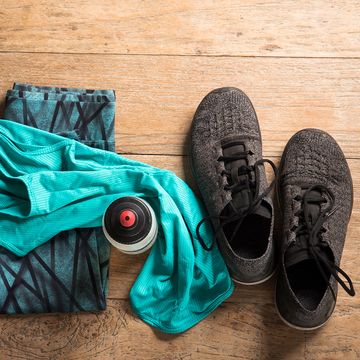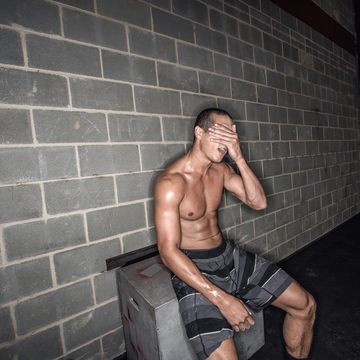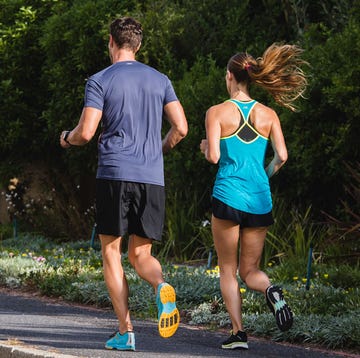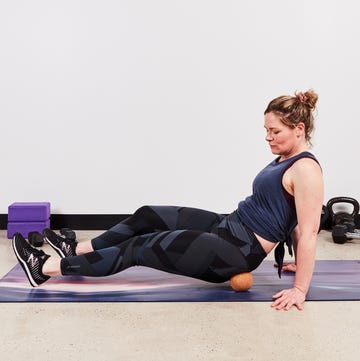When I think of the summer I spent on Nantucket, I think about my six-mile runs to the ocean. What I remember most is taking in the sights of still ponds, the buzz of open-air jeeps, and the feel of uneven cobblestones beneath my sneakers as I cut through the town center. No music. No phone. Just me and a few uncomplicated, tech-free miles in a picturesque setting. Taking it all in left me feeling calm and centered.
To reach this zen-like state—one in which we exert physical effort with ease—we have to tune into our senses, explains Christina Heilman, Ph.D., certified strength and conditioning coach in Driggs, Idaho, and author of Elevate Your Excellence.
A “sensory run” is one in which you let go of your mind and focus on what’s going on inside and around you through the five main senses: sight, smell, taste, hearing, and touch. Heilman says doing so allows you to be truly present (without judgment) and helps you tune into what your body needs in that moment.
It may seem rudimentary, but leaning into those sensations can make you a better athlete. “If you’re interested in training, competing, and improving, you have to pay attention to what’s going on inside your body as well as how that relates to what’s going on outside,” says Jack Raglin, Ph.D., a sports psychologist and kinesiology professor at Indiana University Bloomington. And this sensory-focused approach can help you push your performance to the next level, too. Research finds that elite athletes (more so than non-elite athletes) use sensations such as hydration, muscle pain, and fatigue as well as their surroundings to optimize their runs.
The more you practice turning inward, the better you’ll know your body, the more effectively you’ll tolerate discomfort, and the more you’ll enjoy your time. “You’re less apt to be anxious if you’re able to stay present,” says Jeffery Brown, author of The Runner’s Brain. And since technology such as phones, watches, and apps can cause us to tune out during a run, you’ll find turning inward is easier without any gadgets.
But you don’t need to toss all your toys. The goal of a sensory run is to find time for tech-free miles about once a week. To improve your understanding of your own body while running, Brown suggests cycling through your five senses, focusing on a different one every five minutes. Here’s how doing so can improve your experience.
Sight
Taking in your visual surroundings—people passing by, a mountain in the distance, scenic homes—will help you focus on rewarding details of interest and increase your enjoyment, Raglin says. “It might seem like you’re just looking around, but your brain is trying to create this integrative picture of how you feel moving through space,” he explains. To use sight to your advantage, Raglin recommends spotting landmarks ahead and then speeding up to chase them down, or choosing external benchmarks like the next hill to focus on your form and complete sub-goals.
Smell
Smell is one of the senses most associated with emotional memories, which is why you may recall the salty notes of the ocean air during a run on Nantucket. For performance’s sake, concentrate on smells that may be present along the course you’re training for, suggests Ahmad R. Sedaghat, M.D., Ph.D., an otolaryngologist at Massachusetts Eye and Ear in Boston. For example, zero in on the smell of fresh-cut grass during your training if your race is taking place in a park. This allows you to quickly acclimate to the race setting so you can devote more concentration to actually running, he says.
Taste
“Tastes that are experienced during running can certainly act as a gauge for a runner’s physiological status,” Sedaghat says. Dehydration, for one, can cause saliva to thicken, and because there’s less water in the body, fluids such as sweat and saliva can become more concentrated with salt. If you find your mouth tastes salty, instead of spiraling into worry mode, see it as a signal to take care of yourself, Heilman says. Stop at a water station midrace, find a water fountain during a run, or simply turn back for home if your taste buds are sending signals that you’ll need to replenish soon.
Hearing
No matter where your miles take you, tuning into the sounds around you can enhance awareness. “You’re getting a sense of what’s happening behind you or where you can’t see without needing to avert your eyes,” Raglin says. You’ll be safer knowing a truck is roaring up the road, or you’ll have an early warning if a competitor is about to pass you in a race. During training runs, seeking out sounds you’ve never heard before and trying to find where they’re coming from forces you to be engaged in the moment and increases enjoyment and reward, he adds. To ensure that the little voice in your head saying “I’m tired” doesn’t take over, Brown recommends being really descriptive about what you hear. Instead of simply noting a bird call, imagine what type of bird it is, where it is located, and how the call sounds.
Touch
Summer runs often equal sweaty runs, but pay attention to how that sweat feels on your skin both during exercise and after you finish. “Salty sweat has a similar feeling of caked-on sea water after a swim,” says Amanda Nurse, an elite runner and personal coach in Brookline, Massachusetts. You may notice it feels gritty to touch, which is a sign you lost electrolytes like sodium in your sweat. If you feel salt flakes or crystals when you touch your skin postrun, take in sodium an hour before your next run by consuming something salty like a bag of pretzels or adding electrolyte mix to your water, Nurse suggests. This will help your body retain water and prevent muscle cramps.

Cassie Shortsleeve is a skilled freelance journalist with more than a decade of experience reporting for some of the nation's largest print and digital publications, including Women's Health, Parents, What to Expect, The Washington Post, and others. She is also the founder of the digital motherhood support platform Dear Sunday Motherhood and a co-founder of the newsletter Two Truths Motherhood and the maternal rights non-profit Chamber of Mothers. She is a mom to three daughters and lives in the Boston suburbs.













